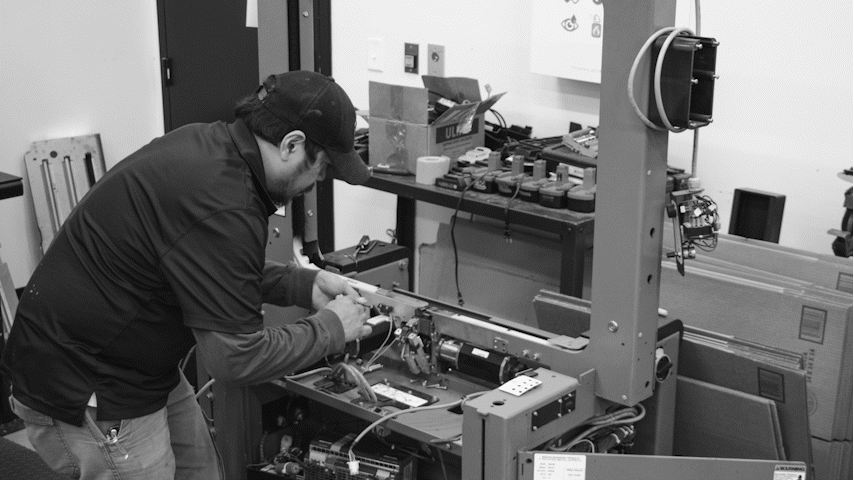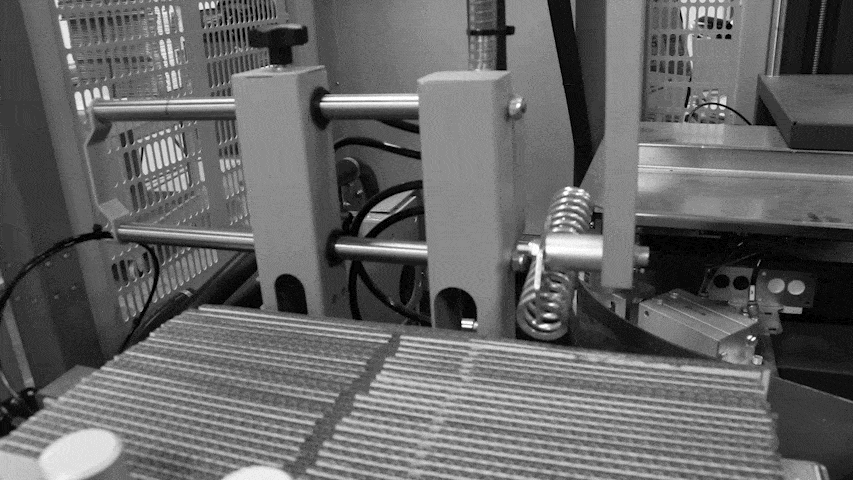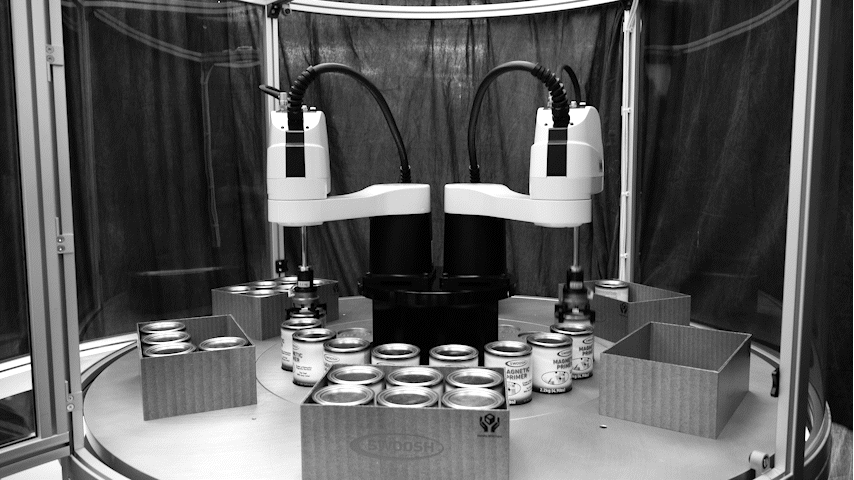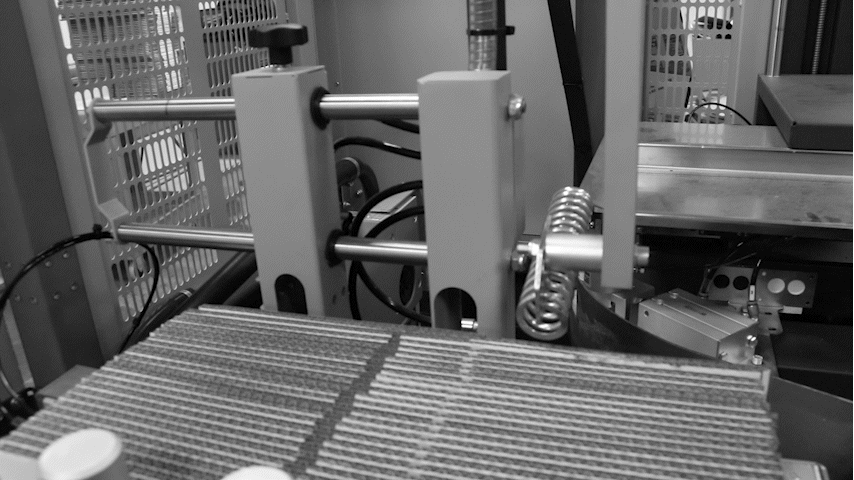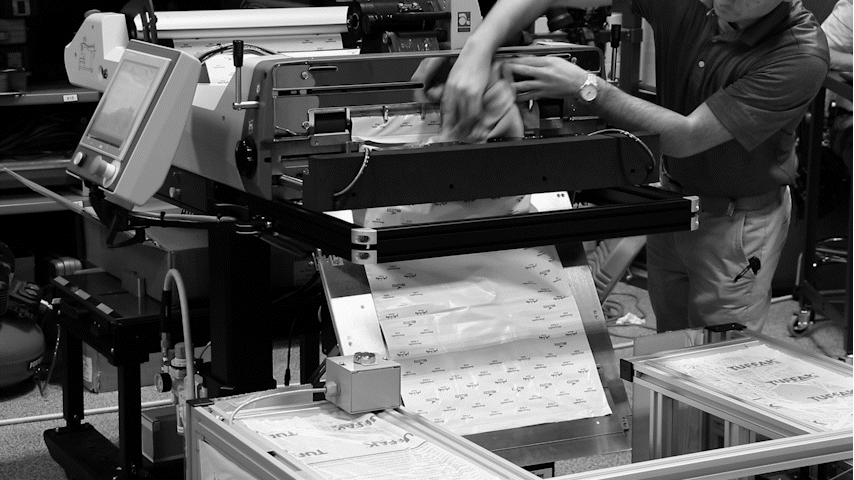Automation Repair | Arnold Automation
We Do The Technical Stuff So You Don’t Have To
In 2017, Arnold Automation launched as a division of Arnold Packaging and we haven’t looked back! We’ve helped hundreds of businesses in the Mid-Atlantic region with tool and automation repair, integration, installation, service and maintenance.
Our customers range from small food and beverage outfits to massive third-party logistics companies. With highly-trained service experts who possess experience and problem-solving talent, we are your ultimate automation partner.
Our Automation Services Include…
Automated Packaging Equipment Installation

When you’ve decided to invest in packaging automation and high-quality hand tools, Arnold Automation is there to protect your investment. First off, our factory-trained installers will get it done right. Take out the guesswork of handling installation yourself.
Then we’ll provide…
On-Site Training and Online Resources
We won’t leave you hanging once the automation is installed. We’ll provide on-site training to your equipment operators.
We’ll also offer access to our online Arnold Academy with videos, schematics and manuals for ready reference. Seeing is believing, so here’s one of our videos about operating a Robopac stretch wrapper:
Preventative Maintenance (PM) / Predictive Maintenance (PdM)
The labor costs of emergency machine repairs can be incredibly expensive, not to mention the lost profitability during unexpected downtime.
“Manufacturers looking to take their automation game to the next level…need solutions that maximize efficiency and address maintenance concerns”
In other words, it pays to be proactive.
We’ll handle your PM or PdM scheduled maintenance of packaging equipment and other automation with replacement parts we have ordered in advance, rather than you paying a premium for the expedited shipping of parts.
Emergency Automation and Hand Tool Repair
Automation downtime can dramatically impact production – and profit – for your business.
Format.io reported that “Industry experts caution about the potential costs of robot downtime…“
To prevent this potential setback in your business operations, you need a rapid-response solution.
Our tool and automation repair service department covers most of Maryland, Northern Virginia, Southern Pennsylvania and Washington, D.C. So when a machine unexpectedly goes down, you don’t have to pay shipping rates to send it out for repair.

Plus, when we handle the repairs, you don’t have to worry about the safety or liability of your own employee attempting to make the repair. We know these tools and machines inside out, and because of that we can offer efficient service and competitive rates.
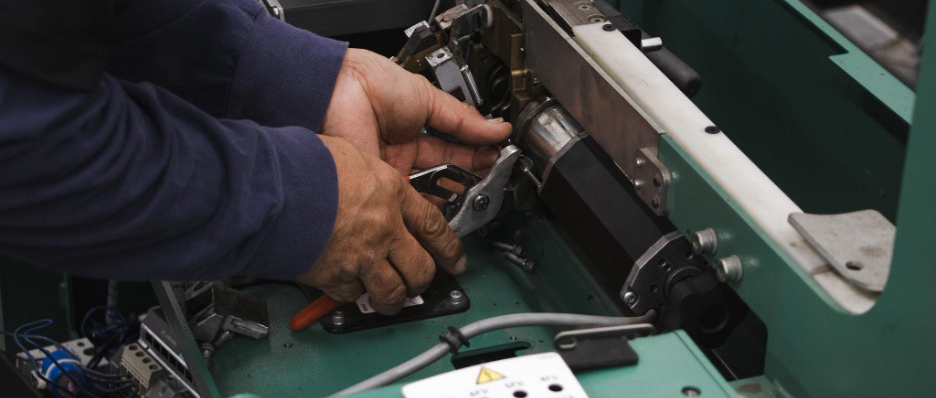
Manufacturers We Work With
Our service team has extensive experience repairing automated packaging equipment and tools from a variety of industry-leading manufacturers including:
To name just a few.
Types of Machines We Service
We service a variety of tools and automation equipment. The list below are some of the more common machines we work with…
- Stretch Wrap Machines
- Shrink Wrap Machines
- Strapping Machines and Tools
- Case Sealers
- Case Erectors
- Inkjet Printers
- Labeling Machines
- Water Activated Tape Dispensers
- Flexible Conveyors
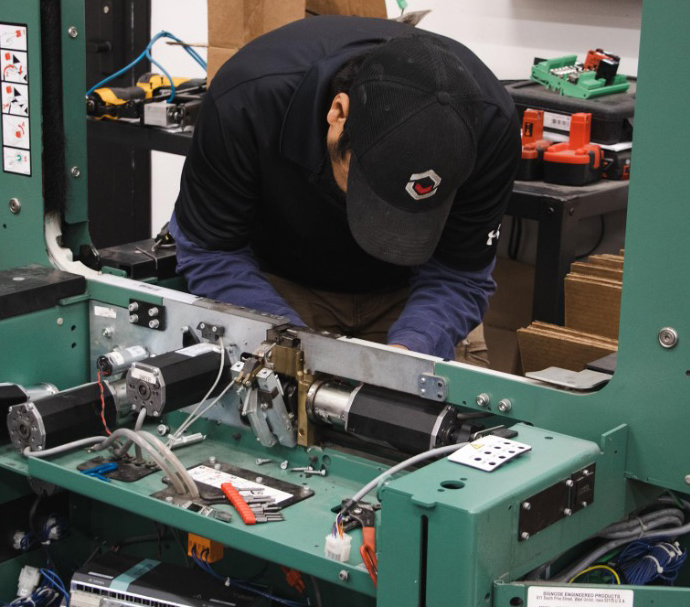
FAQ: Automation Repair for Packaging Equipment
What are the signs packaging equipment isn’t working properly?
Below are some basic signs packaging equipment isn’t working properly, sorted by type.
Your Title Goes Here
Your content goes here. Edit or remove this text inline or in the module Content settings. You can also style every aspect of this content in the module Design settings and even apply custom CSS to this text in the module Advanced settings.
Stretch Wrap Machines
Irregular Wrapping: Uneven or inconsistent wrapping tension.
Excessive Noise: Unusual noises from the motor or moving parts.
Film Breakage: Frequent breaking of the stretch film.
Operational Delays: Slower cycle times or inconsistent wrapping speeds.
Shrink Wrap Machines
Poor Seals: Weak or incomplete seals on the shrink wrap.
Inconsistent Shrinkage: Uneven or partial shrinking of the film.
Overheating: Excessive heat from the shrink tunnel or sealer.
Mechanical Jams: Frequent jamming or misalignment of products.
Strapping Machines and Tools
Loose Straps: Straps are not tight enough around the packages.
Seal Failure: Seals breaking or not holding properly.
Operational Slowdown: Reduced strapping speed or inconsistent performance.
Component Wear: Visible wear on tensioning or sealing parts.
Case Sealers
Tape Misalignment: Tape not being applied straight or securely.
Box Jamming: Boxes getting stuck or misaligned in the machine.
Excessive Noise: Unusual sounds during operation.
Poor Adhesion: Tape not sticking properly to the boxes.
Your Title Goes Here
Your content goes here. Edit or remove this text inline or in the module Content settings. You can also style every aspect of this content in the module Design settings and even apply custom CSS to this text in the module Advanced settings.
Case Erectors
Box Misformation: Boxes not being formed correctly or consistently.
Mechanical Jams: Frequent jamming or misfeeding of box blanks.
Slow Operation: Decrease in operational speed or efficiency.
Component Wear: Visible wear on forming and sealing parts.
Labeling Machines
Misaligned Labels: Labels not being applied straight or in the correct position.
Frequent Jams: Labels getting stuck or misfed in the applicator.
Inconsistent Adhesion: Labels not sticking properly or falling off.
Operational Noise: Unusual sounds indicating mechanical issues.
Water Activated Tape Dispensers
Cutting Issues: Tape not being cut cleanly or accurately.
Poor Adhesion: Tape not being properly moistened or not adhering well.
Mechanical Jams: Tape getting stuck or misfed.
Operational Delays: Slower dispensing or inconsistent performance.
Flexible Conveyors
Irregular Movement: Conveyor belt slipping or moving unevenly.
Frequent Stops: Conveyor stopping unexpectedly or frequently.
Component Wear: Visible wear on rollers or belts.
Unusual Sounds: Excessive noise indicating mechanical issues.
By paying attention to these signs and maintaining a proactive maintenance schedule, you can ensure the longevity and reliability of your packaging equipment.
What’s the difference between Preventative Maintenance and Predictive Maintenance?
Though both are proactive, service that’s planned around usage – or simply regular dates – is known as Preventive Maintenance (PM). This works well for automation that fails in predictable patterns and has limited impact on operations.
Predictive Maintenance (PdM) schedules are based around real-time (crucial) asset conditions – with less predictable fail patterns.
What’s a good schedule for Preventative Maintenance (PM)?
The service frequency for packaging equipment varies based on usage, environment, and manufacturer recommendations. Below are general guidelines for servicing some common packaging machinery. [Note: Always refer to the manufacturer’s maintenance recommendations and adjust the frequency based on your specific usage and operating conditions.]
Your Title Goes Here
Your content goes here. Edit or remove this text inline or in the module Content settings. You can also style every aspect of this content in the module Design settings and even apply custom CSS to this text in the module Advanced settings.
Stretch Wrap Machines Service Frequency
Weekly: Visual inspection, clean sensors, check film tension and condition of rollers.
Monthly: Lubricate moving parts, check and tighten any loose bolts, inspect drive belts.
Annually: Comprehensive inspection by a professional technician, replace any worn parts, and update software if applicable.
Shrink Wrap Machines Service Frequency
Weekly: Clean sealing bars and tunnels, inspect for wear and tear on the shrink film rollers.
Monthly: Check and adjust heat settings, inspect electrical connections, lubricate moving parts.
Annually: Full inspection and maintenance by a technician, replace heating elements if necessary.
Strapping Machines Service Frequency
Daily/Weekly: Clean machine surfaces, inspect straps for proper tension and alignment.
Monthly: Lubricate moving parts, check tensioning and sealing mechanisms.
Annually: Professional inspection and servicing, replace any worn or damaged components.
Case Sealers Service Frequency
Weekly: Inspect belts and rollers for wear, clean the machine, and check tape application.
Monthly: Lubricate moving parts, check and adjust belt tension, inspect electrical components.
Annually: Comprehensive inspection by a professional, replace any worn parts, and check for software updates.
Your Title Goes Here
Your content goes here. Edit or remove this text inline or in the module Content settings. You can also style every aspect of this content in the module Design settings and even apply custom CSS to this text in the module Advanced settings.
Case Erectors Service Frequency
Weekly: Clean sensors and moving parts, inspect for loose bolts or parts.
Monthly: Lubricate mechanical parts, check and adjust pneumatic systems, inspect electrical connections.
Annually: Full inspection by a technician, replace worn components, and update software if necessary.
Labeling Machines Service Frequency
Weekly: Clean sensors and applicator heads, check for label alignment and adhesion.
Monthly: Lubricate mechanical parts, inspect and tighten loose components, check electrical connections.
Annually: Comprehensive inspection by a professional, replace worn parts, and update software.
Water Activated Tape Dispensers Service Frequency
Weekly: Clean water brushes and tanks, inspect the tape path for obstructions.
Monthly: Lubricate moving parts, check and adjust cutting mechanisms, inspect electrical components.
Annually: Professional servicing, replace worn parts, and inspect for any major wear or damage.
Flexible Conveyors Service Frequency
Weekly: Inspect rollers and belts for wear, clean the conveyor surface.
Monthly: Lubricate moving parts, check and tighten loose components, inspect electrical connections if powered.
Annually: Full inspection by a technician, replace any worn parts, and check for structural integrity.
What’s a good time schedule for Predictive Maintenance (PdM)?
A good schedule for predictive maintenance should be tailored to the specific needs and conditions of your equipment and operations. Here’s a general outline that you can customize to fit your requirements:
Data Collection and Analysis
Daily/Continuous Monitoring: Use sensors and IoT devices to continuously collect data on equipment performance (e.g., vibration, temperature, pressure, noise).
Weekly Analysis: Analyze collected data to identify trends and detect any anomalies that might indicate potential failures.
Routine Inspections
Weekly/Bi-weekly: Perform visual inspections and basic operational checks on critical machinery. This includes checking for any obvious signs of wear and tear, leaks, or abnormal noises.
Monthly: Conduct more thorough inspections and routine maintenance tasks such as lubrication, tightening of loose components, and cleaning of filters.
Diagnostic Testing
Monthly/Quarterly: Carry out in-depth diagnostic tests using specialized tools and techniques like ultrasonic testing, thermography, and oil analysis. This helps in identifying issues that are not visible through routine inspections.
Maintenance Planning
Quarterly: Review the collected data and diagnostic test results to plan and schedule any necessary predictive maintenance activities. Prioritize tasks based on the criticality of the equipment and the severity of detected issues.
Semi-Annually: Conduct a comprehensive review of maintenance strategies and adjust based on the latest data, technological advancements, and operational requirements.
Component Replacement and Overhaul
Annually: Schedule the replacement of components that have a predictable lifespan and are nearing the end of their useful life. [Pro Tip: plan for any major overhauls or refurbishments during periods of low operational demand.]
Training and Updating Procedures
Annually: Provide training sessions for maintenance staff on the latest predictive maintenance techniques, tools, and safety procedures.
As Needed: Update maintenance schedules and procedures based on feedback from maintenance staff, changes in equipment performance, or after the introduction of new technologies.
Pro Tips:
Critical Equipment: For highly critical equipment, increase the frequency of data collection and analysis, and perform more frequent inspections and diagnostic tests.
Environmental Conditions: Adjust the maintenance schedule based on environmental factors (e.g., dust, humidity, temperature extremes) that can affect equipment performance.
Manufacturer Recommendations: Follow manufacturer guidelines for specific maintenance tasks and intervals, and integrate these into your predictive maintenance schedule.
By adhering to a predictive maintenance schedule, you can improve equipment reliability, extend asset life, reduce downtime, and optimize maintenance costs. Always keep refining the schedule based on the latest insights and technological advancements.
We’re here to help at Arnold Automation. Complete this quick form for immediate repair services or to schedule a free consultation. You can also contact me directly at the number or email below.

Malcom Moore
Director of Service, Arnold Automation
C: 443-909-6386
mmoore@arnoldautomation.com
Malcolm has over 16 years in the manufacturing and engineering industry. His automation expertise includes preventative maintenance, field service and troubleshooting.



